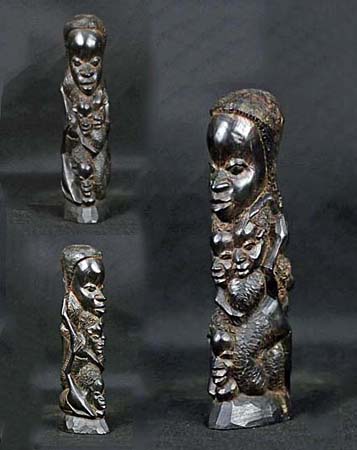
Owner: HWMC
Catalog#: 2AF-OTHR-37
Ritual Symbolism
Makonde 'Ujamaa' - Tree of Life (B)
Southeast Tanzania
Makonde
African Blackwood / Mpingo
1980s
Height: 9.7 in
Other – Ritual Symbolism
According to the African Blackwood Conservation Project, “One of the richest and most emotive cultural expression of the interplay between Dalbergia melanoxylon (African blackwood, Grenadilla, or mpingo) ) and its human users, is the ever-evolving dynamic seen in the work of the Makonde carvers of Mozambique and Tanzania.” The traditions of these African artists reach back in time prior to the late 1400s, when Portugal governed the region known as Mozambique. The Makonde are of Bantu origin, and it is thought they migrated from the west into southern Tanzania and northern Mozambique during the 17th and 18th century to escape Arab and colonial slave traders, and the predation of other tribes.
At first the Makonde carvings were for ritual functions, a part of their cultural practices. During the early 20th century, they became an art form for Portuguese buyers, serving as economic revenue to help the Makonde people reduce the tax burdens of the colonial system. Through the 20th century the Makonde artisans developed three distinctive forms of expression: Binadamu – the depiction of realistic human and animal figures; Ujamaa – an expression of human connectedness and interdependence; and Shetani – imaginative carvings depicting their spirit world.
Seen here is the ‘Ujamaa’ form known as the Makonde ‘Tree of Life.’ According to the African Blackwood Conservation Project this style is attributed to Roberto Yacobo Sangwani, an artist associated with Peera’s workshop. It is constructed in the round from a single trunk of an mpingo tree, symbolizing the interrelations of family, tribal communities, and larger social entities. As the Makonde are a matrilineal society (tracing kinship with the mother), this sculpture portrays mostly women and young children. “In the 1960s and ‘70s, the Tanzanian President Nyerere’s Ujamaa Party adopted the art form as a national symbol of political unity.”
PLEASE NOTE: African blackwood is no longer regarded as ebony, a name now reserved for a limited number of timbers yielded by the genus Diospyros that are more of a matte appearance and are more brittle.
Reference: Makonde Art – African Blackwood Conservation / Barstow, M. (2020). “Dalbergia melanoxylon“. IUCN Red List of Threatened Species. 2020:
